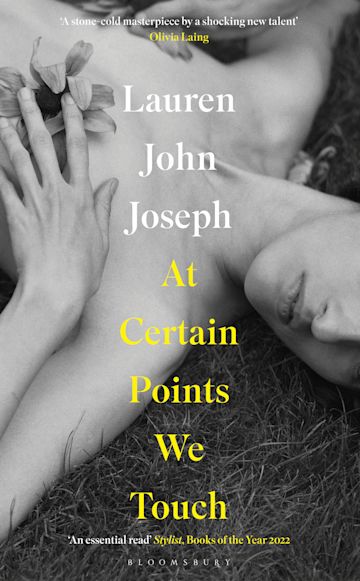Lauren John Joseph’s At Certain Points We Touch is a story of first love and last rites, played out over the course of a decade and against locations in multiple countries. In this exclusive article for Writers & Artists, Lauren reflects on some of the challenges they faced when writing time and place, as well as their journey to becoming a debut novelist.

My novel At Certain Points We Touch spans a decade, and half the globe. Although we have a protagonist writing from their desk in Mexico City, the story they tell us moves from London to San Francisco to New York, via sojourns in Berlin, Athens, Los Angeles and Istanbul. It is an expansive narrative which uses travel, the search for one’s place in the world and a certain weariness towards that world, to dramatise the push and pull of the extremely volatile love affair which smoulders at the heart of it all.
From the off I knew this was going to be a book that cut a great swathe across the globe, with the protagonist running away west towards the USA, and their love moving ever further east, through Europe, the former Soviet states, and into China. (The great cosmic joke being of course, that when living on a spherical planet, two people running in opposite directions are ultimately bound to collide again). I wanted a world which felt boundless, in which the characters could run on forever, or at least until they realized how pointless it was to run on, that in fact everything they ran from would arrive with them when next they stopped - like Furies, like the creature from It Follows, like William Wilson.
I needed to create a world vast enough for these pharaonic emotions to play out in, but I also wanted this wide-open, somewhat fantastical universe, to be very intimate, and to invite the reader to share in something clandestine and precious. In order to balance these two opposing impulses I pinned down the protagonist, so to speak, and placed them in Mexico City, a trick which allows for a much more spacious memorialising of the past. Where previously they had narrated from various places around the world, in the final form of the novel the narrator is stationery at their desk; from this distance they can talk very plainly about the past, and all the places it has taken them. They can talk critically or disloyally even, recognising the various cities they have lived in as having an image, a reputation, an identity that is entirely fabricated, manufactured through processes similar to those with which we create ourselves.
So that the reader would feel a little less nauseous from all of this endless globe-trotting, I also made use of some personal memories, grounding memories, specifically of favourite diners, caffs and fonditas from my own travels. Each of the main cityscapes in the book has a dining scene; in London it’s set in the much missed Stockpot, in San Francisco it’s El Farolito, and in New York it’s Kellogg’s Diner. I’m hoping that such a homely touch as this helps anchor some of the more experimental storytelling, as well as recreating an ambience I associate with each city, be that the starchy aura of spotted dick and custard, the sleazy mood of a grilled American cheese, or the optimism of a veggie burrito with a side of guac. From these greasy spoon scenes the narrator is then able to leap outwards and start riffing on memory, heartache and connection, sex, loss and friendship, in much the same way a really good dinner conversation meanders and expands to encompass all of life’s most tender stories.
 Time and place are flip sides of the same coin here, and though I have endeavoured to plot the geographic location of the scenes with deliberately placed physical markers in the text, there are also scenes in which multiple timeframes overlay in the same space. For example one chapter is set in a nightclub, with the narrator looking back on a pivotal moment in their life which took place there, examining their memory to see how things might have been different. Whilst investigating the past however, they discover a memory inside of the memory, and begin reflecting on the past from the past.
Time and place are flip sides of the same coin here, and though I have endeavoured to plot the geographic location of the scenes with deliberately placed physical markers in the text, there are also scenes in which multiple timeframes overlay in the same space. For example one chapter is set in a nightclub, with the narrator looking back on a pivotal moment in their life which took place there, examining their memory to see how things might have been different. Whilst investigating the past however, they discover a memory inside of the memory, and begin reflecting on the past from the past.
These concentric circles of reverie were some of the most difficult sections to write, because they stack three temporal points of view on top of each other; the now the narrator writes in, the events they are remembering, and the previous events they remember remembering. At times it became so amorphous and frustrating to try and write that I was close to cutting my losses and going back to write out each strand individually. Luckily though, I started experimenting with compound tenses and found my way through the quagmire, mere moments before the urge to hurl my laptop through a window overcame me completely. Joking aside, (momentarily) it also felt like the most honest way of writing about memory, to leave it dense, ambiguous and hazy, to allow the prose to flow, in unexpected directions, just as memory does.
Having taken this journey as a writer over the past four years, from first sitting down in a bookshop café in Mexico and thinking “Well, why not?”, through the endless rewrites, self-doubt and bouts of despair, to the thrill of landing an agent and a deal, then back again through endless rewrites, self-doubt and bouts of despair, and finally on to victory (as evidenced in my having been asked to ink this screed) I can honestly say that writing this book has been one of the great delights of my life, challenges, and exasperations not withstanding. In fact, they have probably made it all the more divine.
At Certain Points We Touch by Lauren John Joseph is available to buy now
Lauren John Joseph was born in Liverpool and lives in London, they write for the page, the stage and the screen. Their film and performance work has been shown internationally across the UK, US, Europe and Asia. They are the author of the plays Boy in a Dress and A Generous Lover, and the experimental prose volume Everything Must Go. This is their first novel.
Comments